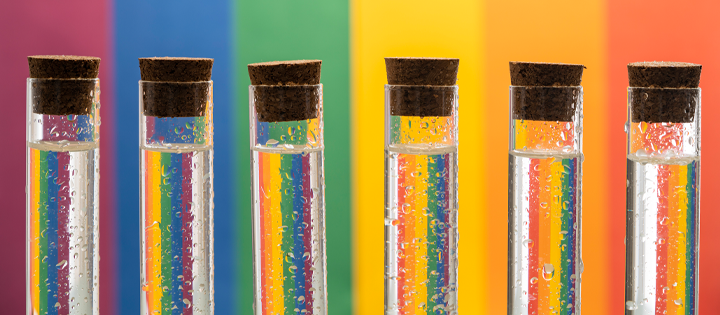
Guest blog by Assistant Professor Andrew Nortcliffe and Assistant Professor Miriam O’Duill, as part of LGBT+ History Month 2023.
Carolyn Bertozzi recently became the eighth woman to win the Nobel Prize for Chemistry in the prize’s 120-year history. She joins Frances Arnold, Emmanuelle Charpentier and Jennifer Doudna in being the fourth female laureate to win in the past five years and the seventh award for biological chemistry in the past decade. The Nobel Prize in Chemistry is awarded for revolutionary research with widespread impact both in academia and industry. Specifically, Bertozzi wins the award for ‘bioorthogonal chemistry’, i.e. the development of spring-loaded trigger molecules that react in living tissues. Inspired by biological processes that occur naturally in some organisms, she has invented a whole new field of chemistry.
Human cells are a bit like M&Ms: their core is surrounded by a sugar coating that controls how the cell interacts with friends and foes around it. Understanding this sugar coating can help us understand the immune system and diseases. Together with her team of researchers, Bertozzi investigates the sugar coating that covers human cells. By feeding cells chemically modified sugars and then exposing them to their new spring-loaded molecules, they were able to look at the cells under a microscope and see where the sugars are.
The trigger molecules themselves can be made to fluoresce with different colours allowing for a technicolour tapestry of sugars to be visualised. In 2008, Bertozzi and her co-workers demonstrated that this technique worked in a living organism by applying it to a zebrafish to see how the sugar molecules were distributed throughout the tissues. Bertozzi’s chemistry is of such importance that it is taught to students in the undergraduate Chemistry curriculum here in Nottingham, and used by some of the research groups working in the School.
As well as being the eighth woman, Bertozzi is the first known lesbian to win a Nobel Prize for a science subject. Her road to success has not been linear. As an undergraduate at Harvard University, she was keen to apply her theoretical knowledge in the lab but struggled to find anyone who would offer her a placement.
This was the first time she became aware of the barriers that exist for women in science, but sadly not the last. Bertozzi came out during the start of the AIDS crisis, a time when the LGBTQ+ community began to mobilise for political change globally; but also a time when your sexuality could be a reason for not being employed. She recalls experiencing “ridicule, exclusion and sometimes outright hostility” as an undergraduate and PhD student due to homophobia and sexism. Her to move to the University of California in Berkeley, San Francisco, was in part motivated because of the strong gay community in the area.
Community is still one of the key drivers for encouraging LGBTQ+ scientists to remain in the field. It is estimated that LGBTQ+ individuals are 20% less likely to be represented in STEM (science, technology, engineering and mathematics) than expected. A recent report commissioned by the RSC found that, even now, 28% of LGBTQ+ individuals consider leaving their careers because of climate or discrimination.
A 2021 study reported that LGBTQ+ scientists were 20% more likely to have experienced professional devaluation and 30% more likely to have experienced some form of harassment. Crucially, though, allyship helps to create a safe, inclusive, welcoming environment that can improve working and learning conditions. Representation matters, but there is a shortage of LGBTQ+ role models in STEM. Now, for the first time, the scientific LGBTQ+ community has a trailblazer at the top of her field winning one of the most prestigious awards; an inspiration to all women and LGBTQ+ scientists for the future.
Throughout her career, Bertozzi has mastered the art of “finding opportunity in failure”, as she explained in a talk at the 253rd ACS National Meeting in San Francisco. Taking each opportunity that presented itself to her – even if, at the time, it looked like a dead end or detour from the goal she was working towards – transformed her into an interdisciplinary pioneer unafraid of taking risks.
She emphasised that there is no one correct path to happiness and success, and some of her greatest ideas were sparked by chance encounters (as well as perseverance and hard work). Her advice to young scientists is to always keep an eye out for interesting opportunities, and to reach out to supportive peers and mentors.
Get involved
The School of Chemistry in Nottingham holds an Athena SWAN Silver Award for our work in gender equality. You can read more about this on the University Athena SWAN pages.
Throughout the University there are many opportunities for staff and students to get involved in projects to support EDI (Equality, Diversity and Inclusion). For example, the Sphere Programme sets annual challenges and supports projects led by students and staff. The University also has an active LGBT+ Student Network and LGBTQIA+ Staff Network and has recently established its first LGBTQIA+ Steering Group – look out for more information during this month’s LGBTQ+ History Month events.
More information
Details about the science behind the Nobel Prize for Chemistry 2022 can be found at The Nobel Prize in Chemistry 2022 - Popular information and The Nobel Prize in Chemistry 2022 - Scientific background.
If you would like to read more about Carolyn Bertozzi’s experiences and views, please explore the links below:
Assistant Professor Andrew Nortcliffe and Assistant Professor Miriam O’Duill
13 February 2023